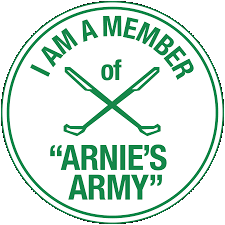The Ten Golden Golf Rules
Welcome to The Ten Golden Golf Rules
The Ten Golden Golf Rules is not meant to replace the Official Rules Book, but you gotta agree the complete book of The Rules of Golf can get ridiculously complicated and sometimes very confusing for the “average” golfer.
Luckily for most of us amateurs, the “Ten Golden Golf Rules" that follow are enough to get us through our daily rounds and even the “friendly” games we play with our buddies.
The Original Rules of Golf issued in 1744 by the Honourable Company of Edinburgh Golfers consisted of just 13 rules and a total of only 340 words. In contrast, today’s book lists 34 Rules in 122 Sections with 106 Sub-Sections that fill a 126-page pocket-sized booklet. To that, we then get to add the “Decisions” Book that is almost 600 pages in length – Wow!!!.
Although the rules are there to govern the conditions of play and keep the game fair to everyone participating, unless you play professionally or at the highest levels of very competitive amateur golf, then in the interest of speedier play (and less arguments among friends), we offer the following Ten Golden Golf Rules that should do just fine.
* Note By no means are we advocating that anyone abandon or ignore the complete rules of golf as issued by the USGA in cooperation with the R & A of Scotland.
We only offer the following Ten Golden Golf Rules as a simplified guideline that can provide golfers with a basic understanding of the rules and enough knowledge of them to get through most situations they will face in their daily rounds of amateur golf. Use them wisely – but we also recommend that every golfer carry a copy of the Official USGA Rules of Golf booklet in their bag for proper reference when the situation demands a more finite review of the rules.
These Ten Golden Golf Rules have been excerpted from an updated version of the original collaboration between the USGA and Golf Magazine in their attempt to create a simplified version of the rules. This “simpler version” could help the average golfer to compete fairly among friends while not being burdened with a complete understanding of the comprehensive rules of golf that would usually only lead to confusion and arguments during and after the round.rules
Hit ‘em Straight . . . and not Too Often!!
The Ten Golden Golf Rules
|
1. |
You MUST play the ball as it lies – unless otherwise governed by one of these other conditions. |
 |
|
2. |
You can’t press anything down or bend, break, or move anything growing or fixed in place, except in the act of taking your stance (e.g. - you can step into a bush or a tree and move the branches with your body, but you can not break or snap any branches during any swing of the club). |
|
3. |
You may lift and move any Natural or Man-Made Objects – like twigs, mowed grass, trash, bugs, rocks, etc. (no matter the size – remember the controversy when Tiger Woods had members of the Gallery help him move a huge boulder that stood in the way of his desire to “go for the green” on his second shot on the 585 yard par 5 13th hole at the 1999 Phoenix Open?) that are not growing or fixed in place with no penalty incurred, except in a water hazard or in a bunker. |
|
4. |
For Immovable Man-Made Objects, such as cart paths, sprinkler heads, course buildings like maintenance sheds, yardage posts and markers, etc. you may take relief with no penalty by dropping within 1 club-length of the nearest point of relief that is no closer to the hole, except if the ball is in a water hazard or if the object defines the out of bounds (like a fence). When dealing with Immovable Natural Objects such as trees, bushes, boulders, cacti, etc., see Golden Rule # 9. |
|
5. |
You are also granted free relief with no penalty incurred from casual water, ground under repair, burrowing animal holes and dangerous animals (e.g. – snakes and alligators), by also taking “full relief” from the obstruction. If your ball is on the green, relief is taken at the nearest point of relief that is no closer to the hole. In all other locations, the ball must be dropped within one club-length of the nearest point of relief that is no closer to the hole. |
|
6. |
While in a bunker or water hazard, do not touch the water or the ground with your hand or the club unless in the act of making your swing at the ball. |
|
7. |
After hitting a ball (that you cannot find) into a water hazard, you have the choice of either dropping behind the point where the ball last crossed the margin of the hazard (going back as far as you wish along the line that keeps that point between you and hole), or from the place where you had hit your last shot – under penalty of one stroke. If that shot had been played from the tee, you may re-tee your ball. Hitting your ball into a lateral hazard gives you the option of, under penalty of 1 stroke, dropping within 2 club-lengths of the point where the ball crossed the margin of the hazard, or within 2 club-lengths of a point equidistant from the hole on the opposite margin of the hazard. |
|
8. |
For any ball hit out of bounds or that can not be found after the allotted 5-minutes of searching, you must add a penalty stroke and return and replay the shot from the spot at which that last shot had been played. From the tee, you may tee the ball again. Any time you believe you may have hit your ball out of bounds or that it may be lost anywhere other than in a water hazard, you should play a provisional ball before searching for the first one. |
|
9. |
When you otherwise have an “unplayable” lie, you again have the choice (under penalty of one stroke) of either replaying the last shot, or dropping within 2 club-lengths at a spot no closer to the hole that grants relief from THAT obstruction (keeping in mind that it may very well drop you into another "unplayable" lie requiring another penalty stroke and another drop), or at any distance along the line behind the unplayable spot keeping that spot between you and the hole. If the ball is in a bunker, you must drop your ball in the bunker under either of the two options just mentioned. The exception to the one stroke penalty is any “unplayable” ball embedded in what would otherwise be a legal spot from which to play (e.g. a ball in a soft fairway that is at least halfway embedded into the soft turf). |
|
10. |
Ball marks and old hole plugs on the putting green may be repaired, but spike marks may not. |
Join GolfNow's GolfPass Program
For Great Savings on ALL your Golf
Return to The Top of Ten Golden Golf Rules
Go to The Original 13 Golf Rules
?? Your Own Website ??
Is there a topic or a hobby for which you have a strong passion?
Have you ever considered turning that passion into a passive income stream?
Have you ever considered creating a web site like this one?
I researched long and hard for the best resources available on the web to assist me in making The-Golf-Experience.com a reality and I found none better than Solo Build It with whom to partner.
Above and beyond the comprehensive program they provide to assist you on your journey is the incredible level of customer service you'll get along the way. The world would be a better place if every company out there modeled the quality and level of their customer service after what Solo Build It seems to provide with such ease.
Watch the video below to see if your interest in creating your own web site gets a spark.
You ready?
Now click the "Solo Build It!" link below to begin your own journey.
Good luck and have some fun.
© Copyright The-Golf-Experience.com
"When Health is absent, wisdom cannot reveal itself, art cannot become manifest, strength cannot be exerted, wealth is useless, and reason is powerless."
Herophilos 335-280 B.C.
All athletes require the performance components of: strength, power, endurance, flexibility, coordination, balance, good posture, and mental conditioning to perform at their best.
Stay Healthy - Play your Best
~ ~ ~
Visit our Fitness Page to learn more!
Start investing with Acorns today and they'll add $5 to to your account to help you get started - You won't retire on their contribution ... but $5 is still $5
Visit our page on Golf Balls to learn ALL you need to know to determine which ball is best suited to your unique swing speed and style of play.
Then visit Lost Golf Balls below to buy used golf balls in the quality suited to your game and the quantity required to keep your bag full.
Find Inexpensive Gas with Gas Buddy
If you really want to save at the pump though - Get yourself a Pay With Gas Buddy Card.
Join for free to save $.05 per gallon or get a Plus or Premuim Membership to save $.20 per gallon.
Points are awarded for each score on every hole. You can use any modification for points awarded (or subtracted) on every hole, but the R&A and the USGA award points as follows:
If you appreciate exceptional customer service and personal attention given to filling your golf needs The-Golf-Experience.com highly recommends shopping with



























New! Comments
Join the conversation by sharing your comments and opinions about the content on this topic in the box below.